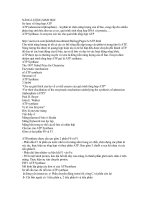Năng lượng sinh học
Bạn đang xem bản rút gọn của tài liệu. Xem và tải ngay bản đầy đủ của tài liệu tại đây (1.76 MB, 42 trang )
1
Chemical
Thermodynamics
NHIỆT ĐỘNG HỌC
TRONG SINH HỌC
2
Chemical
Thermodynamics
Định luật 1 nhiệt động học
(First Law of Thermodynamics)
•
Chúng ta biết rằng năng lượng không thể tự
sinh ra và tự mất đi (energy cannot be
created nor destroyed).
•
Vì vậy, tổng năng lượng của vũ trụ là hằng số
( Therefore, the total energy of the universe is
a constant.)
•
Năng lượng có thể chuyển đổi từ dạng này
sang dạng khác hoặc chuyển từ hệ thống này
sang hệ thống khác ( Energy can, however,
be converted from one form to another or
transferred from a system to the surroundings
or vice versa.)
3
Chemical
Thermodynamics
Các quá trình tự phát
(Spontaneous Processes)
•
Quá trình tự phát là quá trình có
thể xảy ra không có sự tác động
của yếu tố bên ngoài
(Spontaneous processes are
those that can proceed without
any outside intervention.)
•
Khí trong bình B sẽ tự phát
chuyển qua bình A, nhưng sẽ
không xảy ra trường hợp ngược
lại ( The gas in vessel B will
spontaneously effuse into vessel
A, but once the gas is in both
vessels, it will not
spontaneously)
4
Chemical
Thermodynamics
Các quá trình tự phát
(Spontaneous Processes)
Quá trình tự phát xảy ra theo
một hướng và không tự phát
theo hướng ngược lại
(Processes that are
spontaneous in one direction
are onspontaneous in the
reverse direction.)
5
Chemical
Thermodynamics
Các quá trình tự phát
(Spontaneous Processes)
•
Quá trình tự phát ở một nhiệt độ nào đó nhưng không tự phát ở
nhiệt độ khác (Processes that are spontaneous at one temperature
may be nonspontaneous at other temperatures.)
•
Ở 0°C nước đá tự tan chảy (Above 0°C it is spontaneous for ice to
melt.)
•
Dưới 0°C quá trình ngược lại là tự phát (Below 0°C the reverse
process is spontaneous.)
6
Chemical
Thermodynamics
Các quá trình thuận nghịch
Reversible Processes
Trong một quá trình thuận nghịch hệ
thống thay đổi theo cách hệ thống
và môi trường xung quanh có thể
trở lại trạng thái ban đầu bởi quá
trình thuận nghịch
(In a reversible process the system
changes in such a way that the
system and surroundings can be
put back in their original states by
exactly reversing the process)
Sự thay đổi là rất nhỏ ở quá trình
thuận nghịch
(Changes are infinitesimally small in
a reversible process.)
7
Chemical
Thermodynamics
Quá trình bất thuận nghịch
Irreversible Processes
•
Quá trình bất thuận nghịch không thể thực hiện quá trình ngược
lại khi hệ thống thay đổi
(Irreversible processes cannot be undone by exactly reversing
the change to the system)
•
Tất cả các quá trình tự phát đều là bất thuận nghịch
(All Spontaneous processes are irreversible)
•
Tất cả các quá trình xảy ra thực tế là bất thuận nghịch
(All Real processes are irreversible )
8
Chemical
Thermodynamics
Entropy
•
Entropy ( S) là thuật ngữ được Rudolph
Clausius đặt ra vào thế kỷ 19
(Entropy (S) is a term coined by Rudolph
Clausius in the 19th century.)
•
Clausius đã xác định ý nghĩa của tỷ lệ nhiệt
lượng và nhiệt độ ở quá trình trao đổi nhiệt
(Clausius was convinced of the significance
of the ratio of heat delivered and the
temperature at which it is delivered)
q
T
9
Chemical
Thermodynamics
Entropy
•
Entropy có thể xem như sự đo lường tính
chất hổn loạn của hệ thống
( Entropy can be thought of as a measure
of the randomness of a system.)
•
Nó có liên quan đến các dạng chuyển
động của các phân tử
(It is related to the various modes of
motion in molecules.)
10
Chemical
Thermodynamics
Entropy
•
Gọi tổng năng lượng là E, và enthalpy là
H , entropy (S)là hàm trạng thái
(Like total energy, E, and enthalpy, H,
entropy is a state function)
•
Cho nên (Therefore, )
∆S = S
final
− S
initial
S
final= Entropy giaiđoạn cuối,
S
initial = Entropy giai đoạn đầu
11
Chemical
Thermodynamics
Entropy
•
Các quá trình xảy ra ở nhiệt độ không đổi ( Quá
trình đẳng nhiệt ), ta có :
(For a process occurring at constant temperature (an
isothermal process)
q
rev
= Lượng nhiệt trao đổi khi quá trình xảy ra ở
nhiệt độ không đổi (The heat that is transferred when
the process is carried out reversibly at a constant
temperature.)
T = Nhiệt độ Kelvin (temperature in Kelvin)
12
Chemical
Thermodynamics
Định luật 2 nhiệt động học
Second Law of Thermodynamics
The second law of thermodynamics: Entropy của vũ
trụ không thay đổi đối với quá trình thuận nghịch và
tăng lên đối với quá trình bất thuận nghịch
The entropy of the universe does not change for
reversible processes and increases for spontaneous
processes.
Quá trình thuận nghịch (Reversible (ideal))
Quá trình bất thuận nghịch Irreversible (real, spontaneous):
13
Chemical
Thermodynamics
Second Law of Thermodynamics
Quá trình thuận nghịch [Reversible (ideal):]
Quá trình bất thuận nghịch Irreversible (real, spontaneous):
“You can’t break even”
14
Chemical
Thermodynamics
Second Law of Thermodynamics
Entropy của vũ trụ tăng, nhưng entropy có thể giảm ở
những hệ thống riêng lẽ ( The entropy of the universe
increases (real, spontaneous processes).
But, entropy can decrease for individual systems.
Reversible (ideal):
Irreversible (real, spontaneous):
15
Chemical
Thermodynamics
Entropy ở mức phân tử
(Entropy on the Molecular Scale)
•
Ludwig Boltzmann đã mô tả khái niêm entropy ở mức
phân tử (Ludwig Boltzmann described the concept of
entropy on the molecular level).
•
Nhiệt độ là sự đo lường năng lượng chuyển động trung
bình của các phân tử (Temperature is a measure of the
average kinetic energy of the molecules in a sample).
16
Chemical
Thermodynamics
Entropy ở mức phân tử
(Entropy on the Molecular Scale)
•
Các phân tử đều có dạng chuyển động riêng (Molecules exhibit several
types of motion)
Sự dịch chuyển: Chuyển động của các phân tử từ vị trí này sang vị trí khác
(Translational: Movement of the entire molecule from one place to
another)
Chuyển động con lắc: Chuyển động tuần hoàn của các nguyên tử quanh
phân tử (Vibrational: Periodic motion of atoms within a molecule)
Chuyển động quay tròn : Sự quay tròn của phân tử quanh trục hoặc quay
theo các liên kết (Rotational: Rotation of the molecule on about an axis or
rotation about
σ
bonds.)









